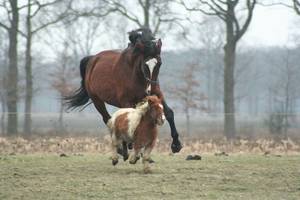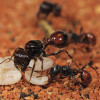Archaeologists revealed this week that people have been riding horses, as well as eating them and drinking their milk for at least 5500 years providing the oldest evidence yet for the domestication of horses.
Alan Outram from the University of Exeter led a team of researchers who picked through archaeological remains of horses left behind thousands of years ago by the Botai people who lived in vast areas of grassland called the Kirghiz Steppe in northern Kazakhstan.
 Their study, published in the journal Science, took several different approaches to find out whether the Botai used domestic or wild horses.
Their study, published in the journal Science, took several different approaches to find out whether the Botai used domestic or wild horses.
First of all, they collected horse bones from the area, in particular the metapodium or cannon, the bone in between the knee and fetlock joint. Because of their important load-bearing role in the leg, these bones have changed shape as horses were domesticated. Outram and his team found that the Botai horses had cannon bones that resembled Bronze Age domesticated horses rather than wild horses from the same region.
They say don't look a gift horse in the mouth, but the team also examined the horses' teeth since a key part of domesticating horses was the use of bridles. The bridle bit goes in the gap between the horses' front and back teeth, and over time this can lead to a distinctive pattern of wear of the enamel, which is exactly what Outram and his colleagues found in these ancient horse remains.
A final question this study looked at was whether or not the Botai people were eating horses. By studying shards of pottery, the archeologists discovered traces of chemicals that indicate not only that the Botai people ate horse meat but that they also collected their milk.
Fatty acids extracted from the pottery were analyzed for the proportion of different versions or isotopes of carbon. Rather like a chemical fingerprint, carbon isotopes can be used to distinguish between the remains of animals that ruminate, including cows, goats and sheep, and non-ruminants like horses. The carbon isotopes extracted form the Botai pottery showed that the fatty acids were indeed from non-ruminant animals, most probably horses.
Measuring the isotope fingerprints of another element, this time deuterium, the team also identified the presence of horse milk in the pottery shards. The key to using deuterium to distinguish between meat and milk is the fact it gets into horses through rainwater. Because it rains less in summer, when mares are in foal, the milk takes on a different summertime fingerprint compared to meat, because horse muscles grow all year round and take on the average deuterium fingerprint for the whole year.
So it seems that the Botai people did indeed domesticate horses and they independently came up with the idea of exploiting them for their milk since across in the Kazakthstan steppes they were a long way from the fertile crescent in the middle east where other agriculture and milking of cows and sheep is thought to have begun.










Comments
Add a comment